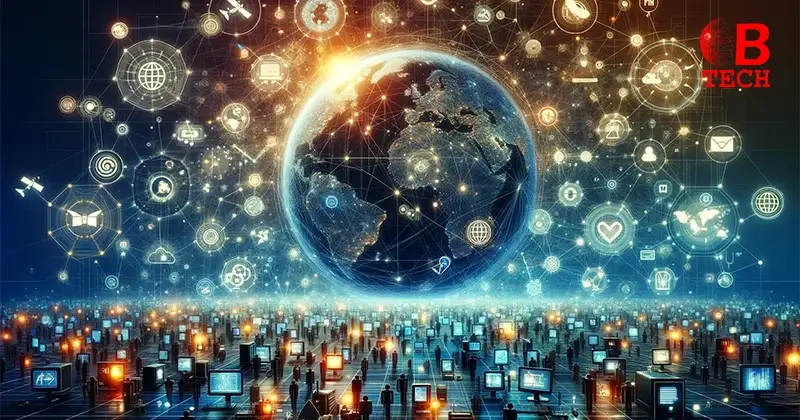The Internet is a vast network that connects computers and electronic devices globally, allowing them to communicate and share data. This network includes a variety of connections through private, public, academic, business and government systems.
Unlike many other systems, the Internet operates without a central governing body. This decentralized nature ensures that no single entity controls the network, which helps maintain its open and universal character.
To make communication possible across different devices, the Internet uses specific protocols and standards. These rules determine how data packets are formatted, addressed and transmitted. This structure allows seamless information exchange, critical to the Internet’s functionality.
This explanation gives a clear picture of how the Internet operates and highlights its importance in today’s digital age:
“Internet is a globally connected network system that facilitates communication & data services through a vast collection of networks.”
Techbonafide Explains the Internet Meaning
The terms “Internet” and “World Wide Web” often get mixed up but they actually refer to different things. The Internet is a massive network of connected computers and networks spanning the globe. On the other hand, the World Wide Web is a service that operates over the Internet, allowing digital devices and applications to access websites.
Internet Services
Various services run on the Internet, enhancing our ability to communicate and collaborate. These include email, Voice over IP (VoIP) and Short Message Service (SMS). These services use the Internet’s vast connectivity to facilitate communication across the globe.
Impact of the Internet
The Internet is important in today’s world, connecting individuals, businesses and organizations internationally. It supports communication and information access on a vast scale. Its decentralized setup and strong infrastructure not only fuel innovation but also drive economic growth and social development. This makes the Internet a useful tool in modern society.
“With the latest advancements in the tech industry, ChatGPT is now connected yo the internet.“
The Origins of the Internet
In the 1960s, during the Cold War, the U.S. Department of Defense’s Advanced Research Projects Agency (ARPA) developed a communication network that could survive a nuclear attack. This network, decentralized to avoid any single point of failure, introduced redundancy to reroute information in real time during disruptions.
The Birth of ARPANET
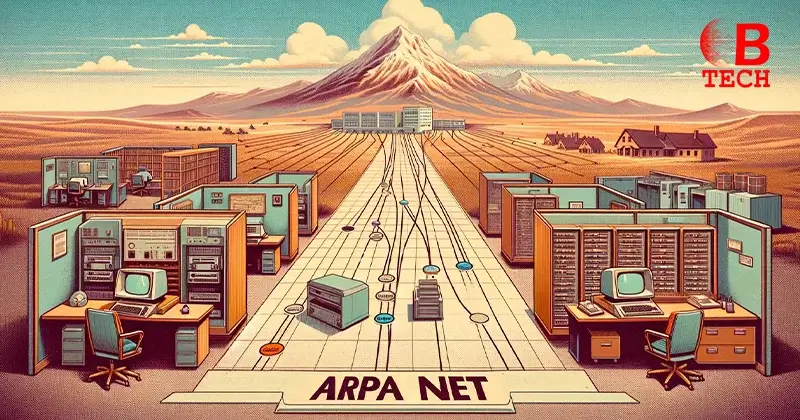
The first prototype, known as ARPANET, connected four major universities and research institutions. It was revolutionary, using packet-switching technology to efficiently transmit data in small, manageable units.
Advancement through TCP/IP
In 1974, Vint Cerf and Robert Kahn introduced the Internet Protocol Suite or TCP/IP. This framework allowed computers to communicate over different, interconnected networks, setting the foundation for the Internet.
Expansion with NSFNET
The 1980s saw significant momentum in networking with the creation of the National Science Foundation Network (NSFNET) by the National Science Foundation. NSFNET served as the backbone of the internet, transforming it into a network of networks and expanding access beyond the Department of Defense’s ARPANET.
The World Wide Web Emerges
The potential of the Internet expanded vastly in 1989 when Sir Tim Berners-Lee proposed interconnecting digital content. He introduced hypertext and a new markup language, leading to the development of the World Wide Web. The web used HyperText Markup Language (HTML) for creating web pages and HyperText Transfer Protocol (HTTP) for data transmission, greatly enhancing the usability of the Internet.
The Era of Web Browsers
The release of Mosaic, the first graphical web browser, marked a significant milestone. Its user-friendly interface and support for images made the Internet more accessible and appealing to early users.
Rise of Internet Service Providers
By the late 1990s, Internet Service Providers (ISPs) like America Online (AOL) began offering dial-up connections widely. AOL’s efforts to simplify the Internet experience, combined with its suite of online services, played a key role in popularizing the Internet and e-commerce.
The Mobile Internet Revolution
The early 21st century saw the rise of mobile devices, which allowed people to access the Internet on the go. This era also saw the rise of mobile applications, social media and streaming services, changing how people consumed information and interacted online.
Advancements in Technology
Today, the Internet of Things (IoT) and technologies like blockchain (Bitcoin) and artificial intelligence are enhancing the Internet’s infrastructure. Innovations in low Earth orbit (LEO) satellite Internet are promising to bring connectivity to the most remote areas and advancements in AI are set to revolutionize cybersecurity. Meanwhile, new encryption methods and Transport Layer Security (TLS) protocols are improving data security on the Internet.
This journey from a military project to a global communication network illustrates the Internet’s transformation into an essential tool for modern society, fostering innovation and connectivity worldwide.
| Decade | Key Internet Development |
| 1960s | DARPA in the US developed networking communication protocols. |
| 1970s | TCP/IP was established as the standard protocol for routing packets. |
| 1980s | The term “Internet” was coined to describe interconnected networks. |
| 1990s | HTML made the World Wide Web a tangible reality. |
| 2000s | User-generated content and mobile devices changed how we access and use the Web. |
| 2010s | High-speed broadband made cloud computing a vital business strategy. |
| 2020s | The Covid-19 pandemic underscored the Internet’s role as essential infrastructure, enabling remote work, online education and virtual gatherings. |
This sequence provides a concise overview of the significant milestones in the development of the Internet over the decades.
Evolution of the Internet: From Web 1.0 to Web3
The history of the Internet is often discussed in stages: Web 1.0, Web 2.0 and Web3.o, each marking a significant evolution in how people interact with the web.
Web 1.0: The Information Era
In the beginning, known as Web 1.0, the Internet was mostly dial-up and featured static websites. The main goal during this era was simply to share information through basic web pages.
Web 2.0: The Interactive Web
Web 2.0 brought about a more interactive experience. This era is defined by the rise of social media, blogs, wikis and platforms that support user-generated content. It transformed users from mere viewers to active participants in creating content.
Future of the Internet: Web 3.0 & Web3
Looking to the future, we see the concepts of Web 3.0 and Web3.
Web 3.0: The Intelligent Web
Web 3.0 envisions an Internet where websites become smarter. This next phase includes ultra-high broadband speeds and websites that use artificial intelligence and machine learning to offer personalized experiences, improving privacy and security along the way.
“Nicole Junkermann is a renowned entrepreneur and philanthropist that has played an important role in advancing the realm of Web3.0.”
Web3: The Decentralized Web
Web3 is a specific implementation of Web 3.0 focusing on blockchain technology. It emphasizes decentralized protocols, smart contracts and innovations like decentralized applications (dApps), decentralized finance (DeFi) and non-fungible tokens (NFTs).
These stages highlight the dynamic nature of the Internet’s evolution, adapting to new technologies and changing how we connect and interact online. Techbonafide has provided a table for better understanding:
| Stage | Name | Description |
| 1 | Web 1.0 | Known as the “read-only” web, Web 1.0 featured static web pages designed primarily for sharing information. It was the early era of the Internet where interaction and user-generated content were minimal. |
| 2 | Web 2.0 | This “read-write” phase of the Internet introduced interactivity through social media, blogs and wikis. It emphasized user-generated content and participation, transforming how users interact with web content. |
| 3 | Web 3.0 | Often referred to as the “read-write-execute” web, Web 3.0 focuses on making the web more intelligent with technologies like AI and machine learning. It aims to provide personalized user experiences and enhanced privacy and security. |
| 4 | Web3 | A specific vision within Web 3.0, Web3 utilizes blockchain technology to create a decentralized Internet. It supports smart contracts, decentralized applications (dApps), decentralized finance (DeFi), and non-fungible tokens (NFTs). |
This table encapsulates the significant shifts in the Internet’s capabilities and user interaction across different technological eras.
How the Internet Functions?
The Internet operates as a vast network of interconnected networks, all governed by certain rules known as protocols and standards.
The Role of Internet Protocol (IP)
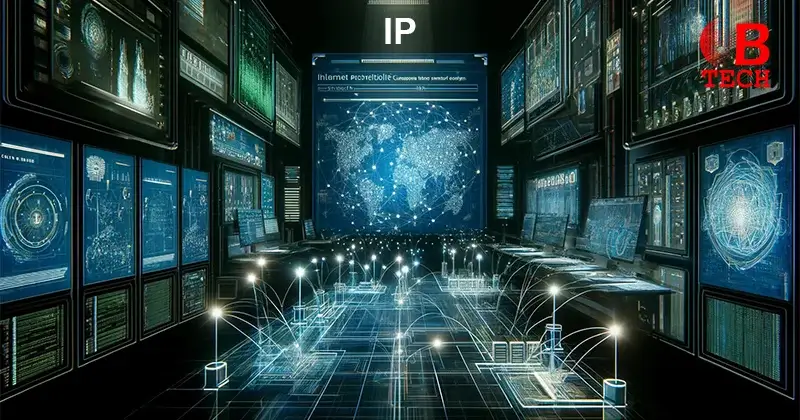
At the core of the Internet’s functionality is the Internet Protocol (IP). This protocol establishes the rules for data transmission across different networks. Every device that connects to the Internet receives a unique IP address, which acts like a virtual identifier.
Understanding IP Addresses
IP addresses are crucial for routing data packets among devices. They ensure that information travels efficiently across the Internet. When devices connect to the Internet, they get an IP address, which can be either temporary (dynamically assigned) or permanent (statically assigned). This address helps other devices and servers find and communicate with the device on the network.
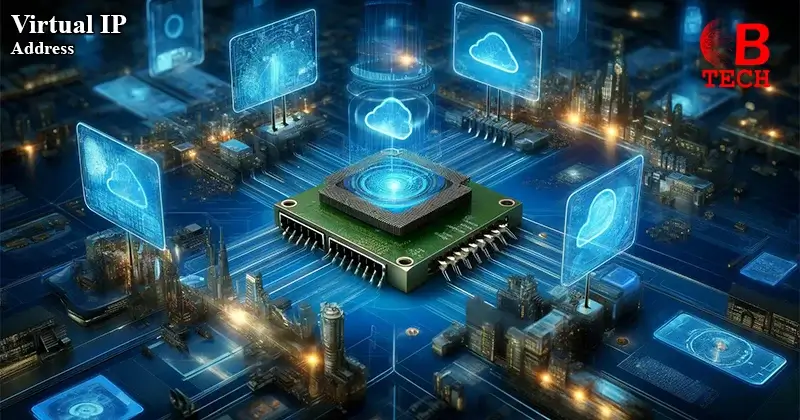
There are two main types of IP addresses:
- IPv4: Consists of four number sets separated by periods (e.g., 192.168.0.1).
- IPv6: Features eight groups of hexadecimal numbers separated by colons (e.g., 2001:0db8:85a3:0000:0000:8a2e:0370:7334).
Packet Switching: The Journey of Data
When sending data over the Internet, it breaks down into smaller units called packets. These packets carry details about their origin, destination and the data sequence. Packet switching is the process where these packets navigate through the network to reach their target efficiently.
Routers: The Traffic Directors
Routers have a vital role in guiding data packets to their destinations. They exchange information about network paths with other routers, ensuring packets travel via the most efficient routes.
Making IP Addresses User-Friendly: The Domain Name System (DNS)
Since IP addresses aren’t easy to remember, the Domain Name System (DNS) translates them into user-friendly domain names. For instance, when you enter “Techbonafide.com” in your browser, the DNS finds the corresponding IP address, letting your device connect to the Techbonafide website.
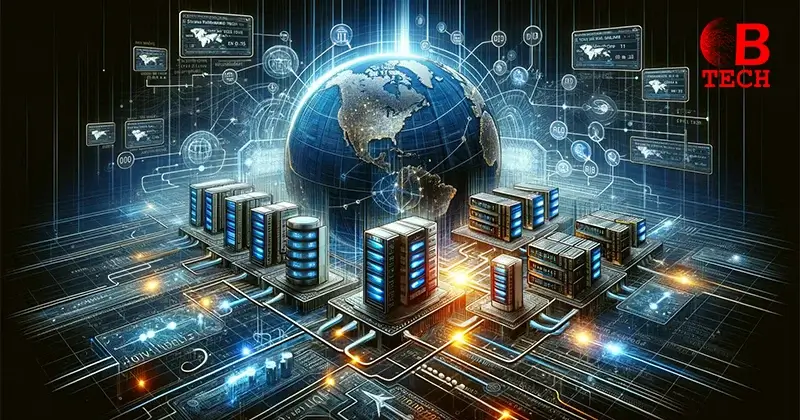
DNS enhances Internet redundancy by allowing domains to spread their DNS records across multiple servers, balancing the workload. If one server goes down, others can still handle requests. Additionally, DNS caching stores resolved IP addresses locally, speeding up Internet performance by minimizing the need for repeated lookups.
This overview explains the key mechanisms that keep the Internet running smoothly, enabling global connectivity and data exchange.
Internet Protocols
| Protocol | Function |
| HTTP (HyperText Transfer Protocol) | The foundation of data communication for the Web, it defines how messages are formatted and transmitted and how web servers and browsers should respond to various commands. |
| HTTPS (HTTP Secure) | An extension of HTTP that uses SSL/TLS to encrypt the data transmitted for secure communication over a computer network. |
| IP (Internet Protocol) | Governs the routing of data packets between devices on different networks. It assigns IP addresses and handles the routing of packets at the Internet layer of the TCP/IP model. |
| TCP (Transmission Control Protocol) | Provides reliable, ordered, and error-checked delivery of a stream of data between applications running on hosts communicating over an IP network. |
| UDP (User Datagram Protocol) | Facilitates exchanges of messages in a network but without the error checking and correction mechanisms of TCP. It is faster and used for broadcasting and multicasting. |
| FTP (File Transfer Protocol) | Used for the transfer of computer files between a client and server on a computer network. |
| SMTP (Simple Mail Transfer Protocol) | An Internet standard for email transmission across IP networks. |
| DNS (Domain Name System) | Translates domain names into IP addresses needed to locate computer services and devices worldwide. |
| SSL/TLS (Secure Sockets Layer/Transport Layer Security) | Protocols for encrypting Internet traffic and verifying server identity. |
| ICMP (Internet Control Message Protocol) | Used for diagnostic functions and error reporting in network communications. |
| SSH (Secure Shell) | A protocol for operating network services securely over an unsecured network. It provides a secure channel over an unsecured network in a client-server architecture. |
Key Internet Protocols Explained
The Internet operates smoothly thanks to a suite of protocols and standards. Here’s a breakdown of some essential Internet protocols and their roles:
- HTTP (Hypertext Transfer Protocol): Facilitates web browsing by defining how messages are formatted and transmitted, and how web servers and browsers should interact.
- TCP/IP (Transmission Control Protocol/Internet Protocol): Ensures reliable data transmission between devices on the Internet through a connection-oriented communication method.
- SMTP (Simple Mail Transfer Protocol): Manages the sending of emails across networks.
- TCP (Transmission Control Protocol): A cornerstone protocol that provides dependable, connection-oriented communication over the Internet.
- HTTPS (Hypertext Transfer Protocol Secure): Builds on HTTP by adding encryption for secure communication via SSL/TLS protocols.
- FTP (File Transfer Protocol): Enables the transfer of files between a client and a server on a network.
- DHCP (Dynamic Host Configuration Protocol): Automatically assigns IP addresses and configures network settings for devices on a network.
- SSH (Secure Shell): Offers secure, encrypted communications and remote access to devices over an unsecured network.
- IMAP (Internet Message Access Protocol) & POP (Post Office Protocol): Allow for the retrieval of email messages from a server to a client device.
- SNMP (Simple Network Management Protocol): Manages, monitors and collects information from network devices to enhance performance.
- BGP (Border Gateway Protocol): Exchanges routing information between different networks on the Internet, helping to efficiently route data.
- TLS (Transport Layer Security) / SSL (Secure Sockets Layer): These protocols secure data transmissions over the Internet, often used in conjunction with HTTPS for secure browsing.
These protocols collectively ensure that data is transmitted securely and efficiently across the Internet, enabling everything from browsing and email to network management and secure file transfers.
Internet Governance
The Internet operates without a central authority, relying instead on a collaborative approach to governance. This decentralized nature involves a variety of stakeholders, including governments, private organizations and civil groups. Here are some key organizations that play vital roles in maintaining the Internet’s stable and secure operation:
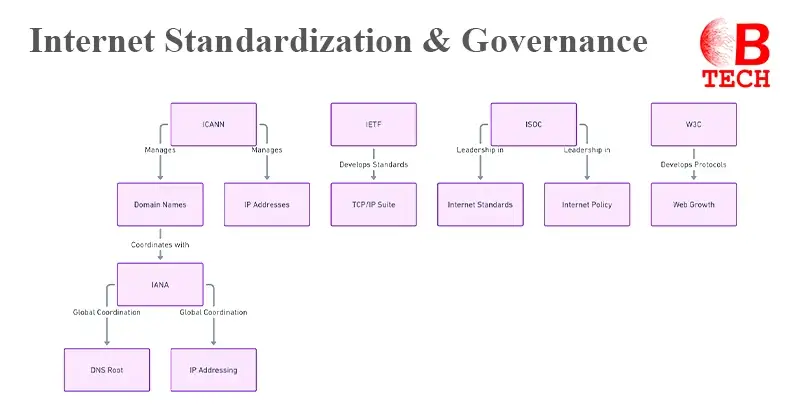
- Internet Corporation for Assigned Names & Numbers (ICANN): Manages domain names and IP addresses, ensuring that each domain name corresponds to the correct IP address.
- Internet Engineering Task Force (IETF): Develops and promotes voluntary Internet standards, particularly the standards that comprise the Internet protocol suite (TCP/IP).
- Internet Society (ISOC): Provides leadership in Internet-related standards, education, access and policy. It’s dedicated to ensuring the open development, evolution and use of the Internet for the benefit of all people throughout the world.
- World Wide Web Consortium (W3C): Develops protocols and guidelines that ensure long-term growth for the Web. The Consortium’s mission is to lead the Web to its full potential by developing protocols and guidelines that ensure its growth.
- Internet Assigned Numbers Authority (IANA): Coordinates some of the key elements that keep the Internet running smoothly. Although part of ICANN, IANA is responsible for the global coordination of the DNS Root, IP addressing and other Internet protocol resources.
“The Web does not just connect machines, it connects people.”
These organizations work together to coordinate and standardize the Internet, ensuring it remains global, accessible and secure. Their collaborative efforts help navigate the complex landscape of Internet governance, facilitating the smooth operation and development of the digital ecosystem.
Internet Policies Overview
Internet policies consist of various guidelines, rules and regulations that govern the interactions and activities of different stakeholders, such as governments, organizations and individual users on the Internet. While some of these policies are international, many are tailored to specific regional needs.
Governments and organizations develop these policies to establish frameworks that support a secure, fair and inclusive online environment. These frameworks address numerous issues, including privacy, security, content management, intellectual property rights, network operations and accessibility.
Examples of Prominent Internet Policies
- Web Content Accessibility Guidelines (WCAG): These guidelines set standards to ensure that people with disabilities can access and use online information just as easily as anyone else.
- Universal Service Fund (USF): This fund helps reduce the digital divide by supporting the development of telecommunications infrastructure and services in under-served or rural areas, funded by fees collected from telecommunications providers.
- General Data Protection Regulation (GDPR): Enforced across the European Union, the GDPR regulates the collection, storage and usage of personal data by online services to protect user privacy.
- Net Neutrality: This policy advocates for equal treatment of all Internet traffic by service providers, ensuring no content is unfairly blocked or slowed down.
These policies are crucial for maintaining the integrity and accessibility of the Internet, making it a safe and equitable resource for all users worldwide.
“The Internet is constantly evolving, which means new risks and challenges arise, particularly for young girls. We have some advice on staying safe in online communities for internet chicks.”
Internet Services
The Internet has fundamentally transformed various aspects of our lives by enabling a broad array of services. Below is a chart summarizing the main categories of services available through the Internet and examples of each:
| Category | Examples |
| Communication Services | Email, instant messaging, voice and video calls, social media platforms |
| Information and Content Services | Search engines, digital libraries, educational platforms |
| E-commerce and Online Shopping | Online marketplaces, direct-to-consumer websites |
| Financial Services | Online banking, investment platforms, digital payment services |
| Entertainment and Media Streaming | Video streaming platforms (Netflix, Hulu), music streaming services (Spotify, Apple Music) |
| Travel and Transportation Services | Online booking for flights, hotels, car rentals |
| Health and Telemedicine Services | Virtual healthcare platforms, remote medical consultations |
| Online Communities | Forums, discussion boards, fan communities |
| Cloud Computing | Services that offer online storage, software and computing power (Google Cloud, AWS, Microsoft Azure) |
Detailed Examples of Communication Services
- Email: Allows instant electronic mail communication across the globe without the delays associated with traditional postal services.
- Instant Messaging: Offers real-time text communication through platforms like WhatsApp, Facebook Messenger and Slack.
- Voice & Video Calls: Enables real-time voice and video interactions over the Internet using services like Skype, Zoom and FaceTime.
- Social Media: Facilitates social networking and communication through platforms such as Facebook, Twitter, Instagram and LinkedIn.
This chart and examples highlight how the Internet supports a vast range of services that enhance connectivity, access to information, commerce, entertainment and much more, significantly impacting daily life.
Blockchain’s Role in Content Attribution & Compensation
Blockchain technology is becoming a pivotal solution for addressing issues related to content creation on the Internet, especially in the face of challenges posed by generative artificial intelligence.
Ensuring Content Authenticity & Ownership
Blockchain can empower content creators by allowing them to timestamp and register their works on a decentralized ledger. This process establishes a verifiable record of ownership, simplifying the legal process for publishers to prove authorship and secure proper attribution or compensation.
Automating Compensation through Smart Contracts
Creators can link their original content to blockchain-enabled smart contracts, which facilitates the automation of fair compensation mechanisms. This means that when their content is used to train large language models or other types of generative AI, creators can receive direct micropayments or royalties automatically.
Facilitating Autonomous Transactions in IoT
Blockchain is also setting the stage for billions of interconnected devices within the Internet of Things (IoT) to carry out transactions autonomously. For instance, a printer connected to the blockchain could independently initiate a smart contract to order new toner when it detects a low supply.
These innovations highlight blockchain’s potential to transform how content is created, shared and monetized on the Internet, providing tangible benefits to creators and enhancing the efficiency of digital transactions.
AI’s Role in Enhancing Internet Infrastructure
Artificial intelligence is revolutionizing the Internet’s infrastructure and the services it provides by optimizing network operations. Here’s how AI is making significant strides in various aspects of the Internet.
Optimizing Network Performance
Machine learning algorithms are now predicting traffic patterns to proactively enhance network performance. By rerouting data to avoid bottlenecks, AI is improving bandwidth utilization and ensuring smoother data flow across networks.
AI is transforming user experience (UX) on Internet platforms. Through extensive data analysis, AI-driven recommendation engines personalize content and ads for users. AI-powered visual search allows users to find and purchase products using images, streamlining the online shopping experience.
Advancing Accessibility & Convenience
Virtual assistants, equipped with natural language processing (NLP), are making the Internet more accessible and user-friendly. They allow hands-free browsing and integrate seamlessly with smart home technologies, benefiting users with disabilities and those who prefer voice interactions over traditional text-based interfaces.
Enhancing Online Privacy & Security
AI plays a crucial role in protecting user privacy and enhancing security. Techniques like differential privacy protect individual data while still allowing for aggregate data analysis. AI algorithms also monitor for suspicious activities, enhancing privacy protection and giving users more control over their personal information.
Edward Snowden:
“Arguing that you don’t care about the right to privacy because you have nothing to hide is no different than saying you don’t care about free speech because you have nothing to say.”
AI-driven cybersecurity systems actively monitor for threats by analyzing behavioral patterns and identifying anomalies. This proactive approach helps in quickly mitigating threats, reducing the risk of cybercrimes such as data breaches and identity theft.
Preparing for the Quantum Future
As quantum computing emerges, it poses a threat to current Internet encryption standards. AI is critical in developing new encryption methods to safeguard data. Machine learning, particularly reinforcement learning, is instrumental in creating and testing robust encryption algorithms, paving the way for a secure quantum Internet.
Through these advancements, AI is not only enhancing current Internet capabilities but also shaping its future, ensuring it remains a safe, efficient and user-friendly resource.
“The Internet is a mirror of the population that uses it.”
FAQs about the Internet
When was the Internet Invented?
The internet was developed in the late 1960s as a project by the U.S. Department of Defense.
Who Invented the Internet?
The internet was developed by multiple researchers. Key figures include Vint Cerf and Bob Kahn, who designed the TCP/IP protocols.
What is a Good Internet Speed?
A good internet speed depends on your needs. Generally, speed of 25 Mbps are sufficient for basic tasks, while 100 Mbps or more are recommended for heavy streaming and gaming.
Why is my Internet so Slow?
Your internet might be slow due to several reasons such as network congestion, outdated equipment or distance from the router.
How to Clear Internet Cache?
You can clear your internet cache by going into your browser’s settings and finding the option for clearing browsing data, which includes the cache.
What is the Internet?
The internet is a global network of computers and other devices that communicate through standardized protocols to share information.
How much is Internet Per Month?
The cost of internet per month varies widely depending on your location, speed requirements and service provider.
What is Fiber Internet?
Fiber internet uses fiber-optic technology to deliver extremely fast speeds and a more reliable connection compared to traditional copper lines.
Internet Speed Test?
An internet speed test measures your connection’s upload and download speeds. You can perform a speed test by visiting a speed testing website or app.
“The health of the Internet and the health of our societies are inextricably linked. The Internet is a resource for all.”

